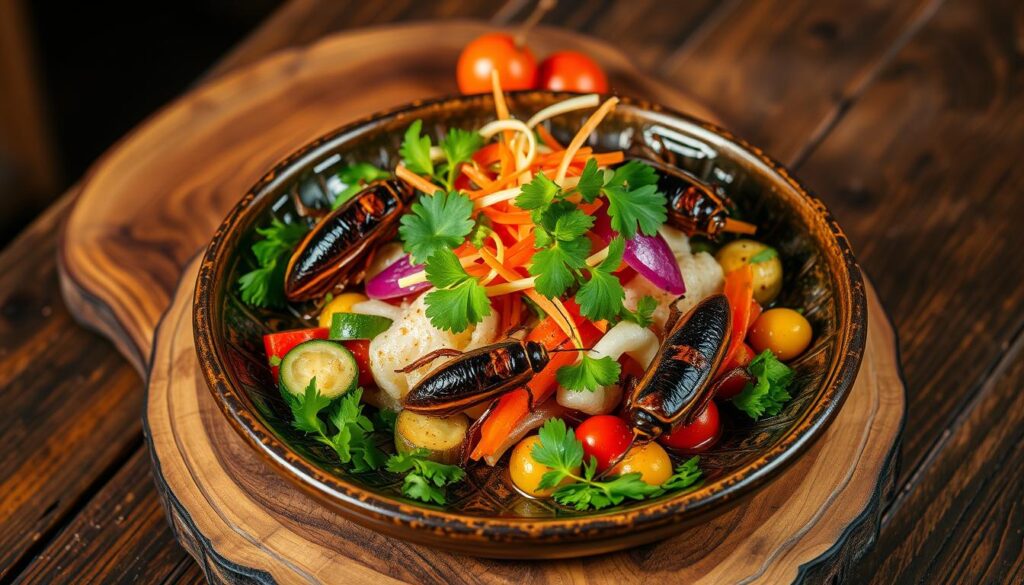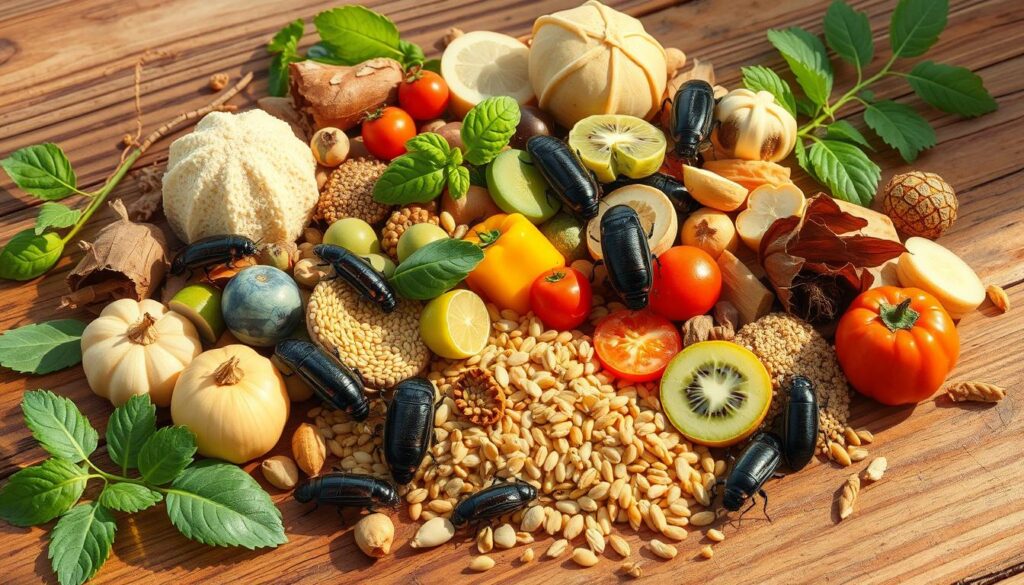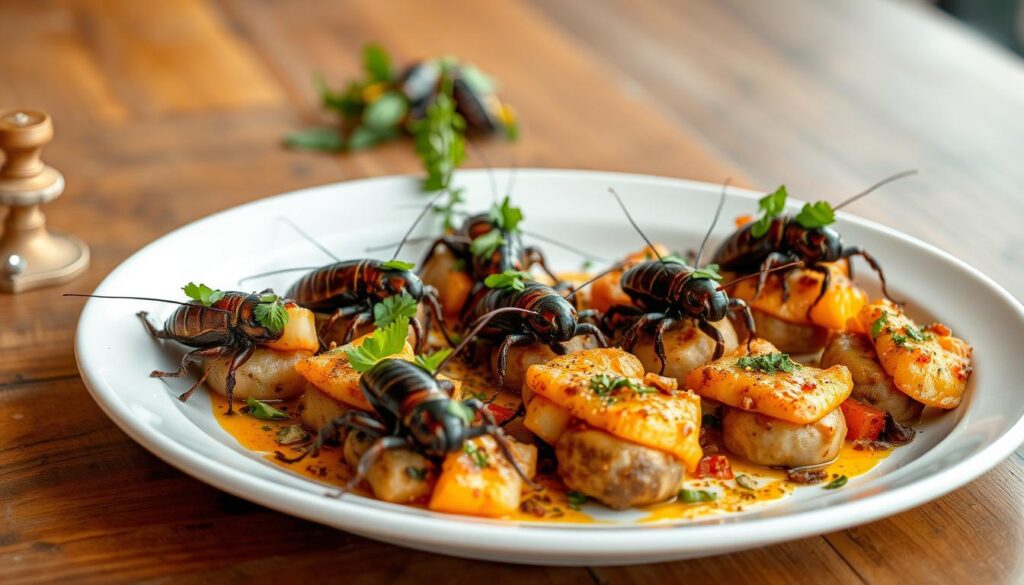Blattodea Food: Discovering the Culinary Uses of Cockroaches
Welcome to the world of blattodea food, where eating insects is becoming trendy. This practice, called entomophagy, is catching on worldwide. Blattodea food lets us discover the nutritional benefits of cockroaches.
In the United States, people are more willing to try new foods, including Blattodea. With a growing need for sustainable food, insect feed is becoming a good choice. It’s a rich source of protein and other important nutrients.

Exploring blattodea food opens up a world of benefits and challenges. From its nutritional value to its use in cooking, there’s much to learn. Let’s dive into the world of blattodea food.
Key Takeaways
- Blattodea food is a growing trend in the culinary world
- Insect feed can provide a rich source of protein and nutrients
- Entomophagy is becoming more popular in the United States
- Blattodea Food offers a unique opportunity for sustainable food sources
- Insect feed can be used in various culinary applications
Understanding Blattodea as a Food Source
Cockroaches have been part of the human cockroach diet for centuries. They are eaten in many parts of the world. The idea of roach cuisine might be new to some, but it’s important in many cultures.
To understand Blattodea food, we must know which cockroaches are safe to eat. We also need to know their cultural importance.
Studies have shown many edible cockroach species. Each has its own taste and health benefits. The American, Australian, and Dubia cockroaches are popular. They are full of protein and important nutrients, making them great for a healthy cockroach diet.
Edible Cockroach Species
- American cockroach: known for its high protein content and mild flavour
- Australian cockroach: rich in micronutrients and has a slightly sweet taste
- Dubia cockroach: a popular choice for roach cuisine due to its tender texture and nutty flavour
The role of cockroaches in food varies by culture. In some places, they are a special treat. In others, they are a common food. Knowing roach cuisine’s history and cultural value helps us see the value of Blattodea food. It also shows how it can help make food more sustainable.
The Nutritional Power of Cockroaches
Cockroaches are packed with protein and other key nutrients. They are a great part of an insectivorous diet. Their protein is as good as traditional livestock, making them a unique protein source. They also have lots of micronutrients like copper, iron, and zinc.
Some of the key nutritional benefits of cockroaches include:
- High protein content
- Rich in micronutrients like copper, iron, and zinc
- Low in fat and calories
As we search for sustainable food, cockroaches are worth looking into. Adding them to your diet can help the environment and give you nutrients. With the right handling and cooking, cockroaches can be a healthy part of your meals.
Modern Applications of Blattodea Food
The food industry has seen big changes, with Blattodea food, or bug meal, becoming part of many products. Knowing how cockroaches eat is key to making new foods. It shows how versatile and promising Blattodea food is in cooking.
Restaurants now offer dishes made from insects, giving customers a new taste. Some dishes include:
- Insect-based burgers
- Cockroach-fed chicken
- Blattodea-based protein powders
Energy bars and snacks are also made with bug meals. This is a green alternative to usual proteins.
By learning about cockroach eating habits, food makers can meet the need for eco-friendly food. Using bug meals in food can cut down on greenhouse gases. It also helps make the food system more circular.
Product Ingredients Benefits
Insect-based burgers Blattodea protein, vegetables, spices High protein content, low fat
Cockroach-fed chicken Cockroach meal, chicken feed Improved nutrition, reduced environmental impact
Blattodea-based protein powders Blattodea protein, flavourings High protein content, sustainable production
The uses of Blattodea food today are wide and exciting. They open up many chances for the food world to grow and meet new needs.
Sustainable Benefits of Cockroach Farming
Cockroach farming is a green choice compared to raising traditional livestock. It’s better for the environment because it uses less food, water, and land. This is thanks to roach dietary preferences, which make farming more efficient and eco-friendly.
Some key advantages of cockroach farming are:
- Lower greenhouse gas emissions
- Reduced water usage
- Less land required for farming
- Lower feed costs
A University of California study showed that insect farming, like cockroach farming, can cut greenhouse gas emissions by up to 90%. This is because cockroaches don’t need as much energy to stay warm. By choosing cockroach farming, we can lessen our environmental impact and build a greener food system.

As the world’s population grows, we need sustainable ways to feed everyone. Cockroach farming is a good option, helping us use fewer resources than traditional farming. By using roach dietary preferences and sustainable farming, we can make food production better for our planet for the future.
Traditional Livestock Farming Cockroach Farming
High greenhouse gas emissions Low greenhouse gas emissions
High water usage Low water usage
Large land requirements Small land requirements
Safe Preparation and Handling Methods
To safely eat insect feed, follow key steps. Clean and sanitize everything, store it right and cook it correctly. Keeping food safe is very important, and these steps help avoid sickness.
Always wear gloves and a mask when handling insect feed. Store it in a cool, dry spot, away from sunlight and moisture. It keeps the feed fresh and safe.
Cleaning and Sanitization
Cleaning and sanitizing are vital for insect feed. Wash and rinse the insects well. Also, clean any tools or surfaces that touch the feed. This stops bacteria and germs from spreading.
Proper Storage Techniques
Storing insect feed correctly is key. Use airtight containers and keep them away from sunlight and moisture. Also, keep the temperature steady. This keeps the feed fresh and safe.
Processing Guidelines
Following processing guidelines is also important. Cook the insects at least 165°F (74°C) to kill germs. This makes sure the feed is safe and clean to eat.
Discover the Diversity of Blattodea Family Types
Handling Method Food Safety Benefit
Cleaning and Sanitization Prevents cross-contamination and the spread of bacteria.
Proper Storage Techniques Maintains the quality and safety of insect feed
Processing Guidelines Ensure the insect feed is cooked to a safe internal temperature
Popular Cooking Techniques and Recipes
Cooking with cockroaches is fun and exciting. It opens up a world of roach cuisine. You can make simple dishes or complex meals using cockroaches. Techniques like roasting, sautéing, and boiling are great for creating tasty meals.
Here are some popular recipes that feature cockroaches as the main ingredient:
- Cockroach stir-fry: a simple and flavorful dish made with sautéed cockroaches, vegetables, and spices.
- Roach soup: a hearty and comforting soup made with boiled cockroaches, vegetables, and broth.
- Cockroach salad: a fresh and healthy salad made with roasted cockroaches, mixed greens, and a tangy dressing.
Many resources are available online for those interested in cooking with cockroaches. You can find recipes, cooking tutorials, and forums. With creativity and experimentation, anyone can master roach cuisine.
“Cooking with cockroaches is not just about sustenance, it’s about exploring new flavors and culinary traditions,” says a food enthusiast.
Whether you’re a seasoned chef or a curious foodie, roach cuisine has something for everyone. So why not try it and discover the delicious culinary uses of cockroaches?
Recipe Ingredients Cooking Method
Cockroach Stir-Fry Cockroaches, vegetables, and spices Sautéing
Roach Soup Cockroaches, vegetables, broth Boiling
Cockroach Salad Cockroaches, mixed greens, dressing Roasting
Health and Safety Considerations
When eating Blattodea food, important health and safety points must be remembered. Some people might have allergies to Blattodea proteins. It can lead to mild symptoms or even life-threatening reactions.

It’s also key to follow food safety rules. Blattodea food, like any other, needs to be handled right to avoid contamination. This means keeping equipment and places clean and following strict quality checks. Blattodea is a nutritious food that must be made and eaten safely for health benefits.
Allergy Concerns
- Identifying possible allergens in Blattodea food
- Coming up with ways to lower allergy risks
- Putting clear labels and warnings on Blattodea products
Food Safety Standards
We must follow strict food safety rules to ensure Blattodea food is safe. This includes testing for contaminants, handling and storing Blattodea right, and keeping quality high. Focusing on food safety allows us to enjoy Blattodea’s health benefits while avoiding illness.
Quality Control Measures
Quality control is vital for safe and good Blattodea food. It means checking facilities, equipment, and products often and watching production closely. With strong quality control, producers can lower contamination risks. It makes Blattodea a healthy and nutritious choice for everyone.
Market Growth and Industry Development
The market for Blattodea food is growing fast. This is because more people want sustainable and new food sources. Market trends show a big increase in demand for bug meal and other insect-based products.
Several factors are driving this growth:
- More people know about the environmental benefits of insect farming.
- There’s a growing need for sustainable protein sources.
- Insect-based food products are entering new markets.
As the industry grows, we’ll see new products. It includes bug meal-based snacks and insect-based meat alternatives.
Market research says the insect-based food sector will keep growing. This is because consumers want healthy and sustainable food. Companies are doing market trends analysis to stay ahead. They want to make the most of the growing demand for bug meal and other insect-based products.
Year Market Growth Projected Growth
2022 10% 15%
2023 12% 18%
2024 15% 20%
Overcoming Cultural Barriers to Insect Consumption
The world is learning about the good of eating insects. However, cultural barriers prevent many from trying it. We must know why people resist and find ways to change their minds.
Education is a big help. It teaches people about the health and environmental perks of eating insects. By sharing clear, interesting facts, folks can choose better diets. Cultural barriers fall when we show how eating insects is valued in many cultures, uniting us all.
Marketing Strategies
Good marketing has helped insects become food. It shows off what’s special about eating insects. Some brands talk about how insects are good for the planet. Others show how tasty and versatile insect foods can be.
Consumer Psychology
Knowing what makes people choose certain foods is key. Companies use this knowledge to make ads that speak to people’s hearts. For example, making insect foods look and taste familiar can win people.
Strategy Example
Education Workshops, online courses, and social media campaigns
Marketing Product labelling, advertising, and influencer partnerships
Consumer Psychology Market research, consumer surveys, and product testing
Using education, marketing, and understanding people’s food choices can help. As more people want food that’s good for the planet, we must tackle these cultural hurdles. This way, eating insects can become more common and accepted.
Conclusion: The Future of Cockroach-Based Foods
The journey through Blattodea food ends with a bright outlook. The nutritional and sustainable benefits of cockroach-based foods are gaining attention. This has opened doors for them in everyday meals.
Looking to the future, blattodea food could be key in solving global food issues. It could be used in space exploration and our daily cooking. The growth and variety in this industry show a promising future. It’s set to change how we eat and make our food system more sustainable.
FAQ
What are edible cockroach species?
Some cockroach species are safe to eat. These include the tropical cockroach, death’s head cockroach, and discoid cockroach. They are farmed for their nutritional value and use in cooking.
What is the global history of cockroach consumption?
Cockroaches have been eaten for centuries in many cultures. In some Asian and African countries, they are traditional foods. They are cooked in many ways, like deep-frying and roasting.
What are the nutritional benefits of cockroaches?
Cockroaches are very nutritious. They have lots of protein, healthy fats, vitamins, and minerals. They are often more nutritious than traditional livestock.
How are cockroaches used in modern food applications?
Cockroaches are now in modern dishes in some fancy restaurants. There’s also a growing market for food products made from them.
What are the sustainable benefits of cockroach farming?
Raising cockroaches is better for the environment than raising livestock. They need less land, water, and food. It makes them a more sustainable choice.
How should cockroaches be prepared and handled for consumption?
It’s important to clean and sanitize cockroaches before eating them. Following food safety rules is key to avoiding contamination.
What are some popular cooking techniques and recipes for cockroaches?
Cockroaches can be cooked in many ways. They can be deep-fried, roasted, or stir-fried. Recipes with cockroaches are found in many cuisines, showing their versatility.
What health and safety considerations should be taken when consuming cockroaches?
Thinking about allergies and following food safety rules when eating cockroaches is important. Doing research and taking precautions is necessary for safety.
What is the current market and industry development for Blattodea food?
The market for Blattodea food, or cockroach-based products, is growing fast. This is because more people want sustainable and new food options. The industry is expanding with new companies and products.
How can cultural barriers to insect consumption be overcome?
To get people to eat insects like cockroaches, we need to educate them. We also need to market them well and address the “ick factor” people have.
